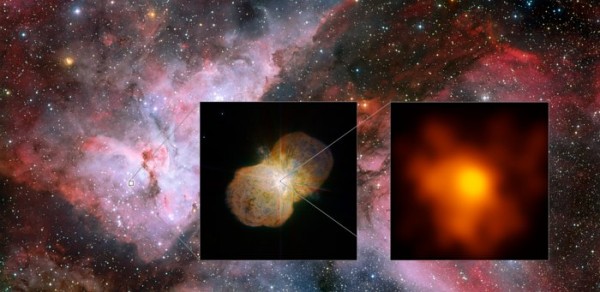By Ana Verayo, | October 20, 2016

This mosaic shows the Carina Nebula (left part of the image), home of the Eta Carinae star system.
Astronomers have captured rare images of one of the heaviest stars in the Milky Way galaxy, revealing violent wind collisions inside a star known as Eta Carinae.
With the help of the Very Large Telescope Interferometer of the European Southern Observatory, astronomers discovered how Eta Carinae formed the dazzling Homunculus Nebula which is a massive, cloud of gas and cosmic dust that are being shaped by powerful stellar winds.
Like Us on Facebook
The Eta Carinae system used to be one of the brightest stars in the galaxy, possessing a luminous glow of five million suns. However, a violent supernova ejected much of its stellar material into outer space, leading the star to lose its brightness in the process.
Now, new imagery reveals the hidden violent forces that are percolating inside the Eta Carinae including more unprecedented detail of the Homunculus Nebula. These images were combined to create a sharper and more detailed composite image from infrared observations by ESO telescopes.
According to Jose Groh from the Trinity College Dublin, astronomers were able to zoom in on this massive, colossal star.
Eta Carinae is not alone, as it is a binary system with a companion star. When the stars orbit each other, they eject stellar material at incredibly high speeds, creating violent stellar winds in the core of that system. These collisions help shape the surrounding nebula that enshrouds the two monster stars.
With these new images, astronomers can now study how massive stars enter their dying stages as they emit the brightest light in the cosmos. These images can also reveal clues about the evolution of the two companion stars that are both emitting massive amounts of star material.
This new study was published in the journal Astronomy & Astrophysics.
-
Use of Coronavirus Pandemic Drones Raises Privacy Concerns: Drones Spread Fear, Local Officials Say

-
Coronavirus Hampers The Delivery Of Lockheed Martin F-35 Stealth Fighters For 2020

-
Instagram Speeds Up Plans to Add Account Memorialization Feature Due to COVID-19 Deaths

-
NASA: Perseverance Plans to Bring 'Mars Rock' to Earth in 2031

-
600 Dead And 3,000 In The Hospital as Iranians Believed Drinking High-Concentrations of Alcohol Can Cure The Coronavirus

-
600 Dead And 3,000 In The Hospital as Iranians Believed Drinking High-Concentrations of Alcohol Can Cure The Coronavirus

-
COVID-19: Doctors, Nurses Use Virtual Reality to Learn New Skills in Treating Coronavirus Patients







